As its name implies, this dog is a small version of the Australian Shepherd. The charm of the Mini Australian Shepherd is undeniable, a fact that became abundantly clear during a recent afternoon spent with my friend’s son. As we scrolled through my phone’s gallery, showcasing the various dog breeds I’ve encountered on my latest adventures, his curiosity was piqued by a particularly adorable Mini Aussie.
“What’s the difference between this Mini Aussie and the big Australian Shepherd?” he asked, his eyes wide with intrigue as he pointed at the screen.
“Well, the Mini Aussie is a smaller version of the Australian Shepherd. They share many of the same characteristics, including their intelligence and energy, but the Mini Aussie is more compact, making it a great option for different living situations,” I explained.
If you, too, find yourself intrigued by these diminutive counterparts to the Australian Shepherd, read the rest of this article to discover their origins, temperament, and why they might be the perfect addition to your family
TABLE OF CONTENTS
- Mini Australian Shepherd Quick Breed Summary
- Physical Characteristics of a Mini Australian Shepherd
- Mini Australian Shepherd Origins
- Mini Australian Shepherd Personality and Temperament
- Mini Aussie Care Guide
- Mini Australian Shepherd Health Issues
- Mini Aussie Cost
- Should You Get a Mini Australian Shepherd?
- FAQs on the Mini Australian Shepherd
- A Compact, Energetic, and Intelligent Companion
Mini Australian Shepherd Quick Breed Summary
Physical Characteristics of a Mini Australian Shepherd
Mini Australian Shepherds are officially known as miniature American Shepherds, according to the American Kennel Club (AKC). Here are more details about its appearance.
Height and Weight
I’ve learned that their size truly sets them apart as a small yet incredibly versatile breed. Standing at 13 to 18 inches tall and weighing between 20 and 40 pounds, these dogs represent a perfect balance of compactness and robust energy. I discovered that females tend to be on the smaller side, which adds to the breed’s diversity. What fascinates me most is how their size doesn’t detract from their agility or intelligence; instead, it seems to amplify their spirited nature. Observing their growth, especially how they reach their adult size within the first 12 months, influenced by diet, activity, and genetics, has been particularly interesting.
Coat
One of the most striking discoveries about Mini Australian Shepherds is their beautiful, medium-length double coats. These coats are not only weather-resistant but come in an array of captivating colors like black, red, blue merle, and red merle, often highlighted with tan or white markings. Running my hands through a friend’s Mini Aussie’s coat, the practical yet aesthetic quality of their fur—straight or wavy on the outside and thick, soft underneath—really stood out to me. However, it’s important to note the increased health risks that merle Mini Aussies face, a fact that underscores the need for responsible care and breeding practices.
Facial Features
The expressive nature of the Mini Australian Shepherd’s facial features has always caught my eye. Their rounded heads, triangular ears, and medium-sized muzzles tapering towards the nose frame their almond-shaped eyes beautifully. These eyes, ranging from brown to blue, hazel, or amber, can be utterly mesmerizing, especially when you see a Mini Aussie with bi-colored eyes. Their alert and intelligent gaze is something that I’ve found to be incredibly engaging, reflecting their keen awareness and vibrant personality.
Mini Australian Shepherd Origins
From Adobe Stock
When I first delved into the backstory of the Mini Australian Shepherd, I was surprised to learn that, despite its name, this breed actually hails from the United States. It turns out that in the 1960s, breeders had the idea to create a pint-sized version of the Australian Shepherd. Their goal was pretty straightforward: keep everything we love about the Aussie—their herding prowess, their friendly temperament, and their role as fantastic companions—but in a more compact package. And, honestly, I think they nailed it.
The more I read, the more I realized that aside from their smaller stature, Mini Aussies and their larger counterparts share a lot in common. Both are incredibly adept at herding, which isn’t surprising given their shared lineage, and they both have the kind of temperament that makes for an excellent family pet. It wasn’t until 2015 that the American Kennel Club (AKC) officially recognized the breed.
Mini Australian Shepherd Personality and Temperament
Firstly, their intelligence is something that constantly amazes me. These dogs are not just smart; they’re whip-smart. They have an innate ability to understand commands and even complex sequences of tasks, which makes training them both a challenge and a delight. I’ve observed that they thrive on mental stimulation, so puzzle toys and interactive games are great ways to keep their minds sharp.
Their temperament is another area where Mini Aussies truly shine. They are incredibly loyal and form deep bonds with their families. This loyalty, combined with their protective nature, means they can be a bit reserved or cautious around strangers. However, once they warm up to someone, they’re as friendly and affectionate as can be. From what I’ve seen, they’re especially good with children, showing a gentle patience that makes them wonderful family pets.
Energetic and playful, these dogs have an enthusiasm for life that’s infectious. Their energy levels are high, which means they need plenty of exercises to stay happy and healthy. I’ve found that they excel in dog sports like agility, flyball, and, of course, herding. Their agility and speed are remarkable, showcasing their herding heritage in every swift move.
Despite their boundless energy, Mini Aussies have a well-balanced temperament that allows them to switch from play mode to chill mode relatively easily. They love being involved in family activities, whether it’s a hike, a road trip, or simply relaxing at home. Their adaptability in these scenarios is something I greatly admire.
Lastly, their sensitivity is a trait not to be overlooked. Mini Aussies are incredibly attuned to their owners’ emotions and have a way of offering comfort without needing to be asked. This emotional intelligence, combined with their loyalty and affection, makes them not just pets but true companions.
Mini Aussie Care Guide
From Adobe Stock
Taking care of a Mini Australian Shepherd is moderately difficult because the breed has boundless energy and needs lots of attention throughout the day. Here is a comprehensive guide.
Feeding
In my quest to understand what fuels these energetic and intelligent dogs, I’ve delved into the nuances of feeding them correctly through every stage of their life. Here’s what I’ve learned:
Puppy Nutrition
I’ve discovered that their rapid growth requires a diet rich in high-quality, nutrient-dense dog food formulated for puppies. This is crucial for supporting their development and energy levels. As such, puppies should be fed three to four times a day to keep up with their fast metabolism. I found it interesting that portion control at this stage can prevent overeating and contribute to a healthy growth rate, avoiding issues like obesity later on.
Adult Nutrition
The dietary needs of Mini Australian Shepherds change as they transition into adulthood around the age of 1. I learned that moving them to two meals a day is a good practice, using adult dog food that suits their energy level and health requirements. The focus here is on maintaining their ideal weight and supporting their ongoing health. It’s essential to consider their activity level when determining portion sizes; an active Mini Aussie will naturally require more calories than a more sedentary one.
Senior Nutrition
Entering their senior years, Mini Aussies often experience a decrease in energy levels, and their metabolism slows down. Therefore, adjusting their diet to a senior-specific formula can help manage weight and support joint health. Feeding them smaller portions more frequently, such as two to three times a day, can aid digestion and nutrient absorption, which is particularly beneficial for older dogs.
Portion Control and Treats
Learning about portion control has been an eye-opener. It’s not just about the amount of food but also the quality of it. Measuring each meal and not deviating too much with treats is key to preventing weight gain, especially given how easy it is for a dog to become overweight without us realizing it. Speaking of treats, I’ve learned they should only make up 10% of a dog’s daily calorie intake. Opting for healthy treats and considering them as part of the overall diet plan is essential for maintaining balance.
Grooming
Given their active nature and double coat, keeping them well-groomed is both a necessity and a way to ensure their comfort and health. Here are grooming tasks you cannot afford to overlook.
Brushing
I’ve learned that regular brushing is crucial for Mini Aussies. Their medium-length, double coat requires brushing at least once a week to prevent mats and tangles. During shedding season, which happens twice a year, increasing brushing frequency to a few times a week helps manage the shedding and keeps their coat healthy. A de-shedding tool or undercoat rake can be particularly effective during these times.
Bathing
Mini Aussies don’t require frequent baths—every few months is generally sufficient, or as needed when they get particularly dirty. Using a dog-specific shampoo that’s gentle on their skin is important to avoid drying out their natural oils. It’s fascinating how a proper bathing routine can also be a great opportunity to check for any skin issues or irregularities.
Nail Trimming
Keeping a Mini Aussie’s nails trimmed is more than just a cosmetic concern; it’s essential for their health. Long nails can lead to discomfort and even problems with walking. I’ve come to understand that trimming their nails every month or so is a good practice, ensuring that the nails don’t touch the ground when the dog stands. If you hear clicking sounds on hard floors, it’s a clear sign that it’s time for a trim.
Ear Care
Given their floppy ears, Mini Aussies can be prone to ear infections. Regular checks and cleaning with a gentle, vet-approved ear cleaner can prevent buildup and keep their ears healthy. I’ve also learned that it’s important to be gentle and thorough, ensuring their ears are dry and clean without going too deep into the ear canal.
Dental Hygiene
Starting dental care early and maintaining a routine of brushing their teeth can prevent dental diseases later in life. I recommend using a dog-specific toothbrush and toothpaste makes this process easier, and it’s something that can greatly impact their overall health and well-being.
Training and Exercise
From Adobe Stock
These dogs are not only physically active but also have a deep need for mental engagement and social interaction. Here’s a breakdown of what I’ve found works best for meeting their comprehensive needs:
Exercise
They need at least 90 minutes of exercise daily, ideally split into two walks, to maintain their physical health and happiness. Despite their small stature, these dogs thrive on high-intensity activities such as herding, agility, and tracking, reflecting their intelligent and job-oriented nature. Their high herding drive, while a testament to their breed’s capabilities, means they should be watched around livestock and young children, whom they might try to herd. This insight has made it clear that despite their adaptability, Mini Aussies are not the best fit for apartment living due to their energetic and outdoor-loving disposition.
Training
The training process for Mini Australian Shepherds has been surprisingly smooth, thanks to their eagerness to please, devotion, and intelligence. Establishing rules from an early age and adhering to a positive reinforcement approach has proven effective in molding them into well-mannered adults. I’ve learned that beginning training as early as eight weeks helps mitigate their herding instincts. As such, I recommend starting with basics like name recognition, socialization, and commands like sit, stay, and come, and then gradually introducing impulse control and behavior around children. Advanced training challenges them further, enhancing their skills and preventing boredom. It’s crucial to avoid punishment-based training, as it can lead to anxiety or aggression, a lesson that has reinforced the value of patience and positivity in training.
Mental Needs
These intelligent, people-oriented dogs crave at least an hour of mental stimulation daily to prevent boredom and anxiety. Puzzle toys, scent work, and interactive play like fetch and tug-of-war not only keep them engaged but also strengthen our bond. The realization that they shouldn’t be left alone for extended periods has highlighted the importance of providing ample mental exercise to keep them content and calm.
Socialization
This breed’s sociable nature and herding instincts make it imperative to teach them how to interact appropriately, ensuring they’re well-adjusted and confident in various settings. The journey of socializing a Mini Aussie will teach you the value of patience and the positive impact of diverse experiences on their behavior and temperament.
Mini Australian Shepherd Health Issues
Mini Australian shepherds are relatively healthy. However, the breed is prone to some health issues, including the following.
Hip Dysplasia
Hip dysplasia is a condition I’ve come to understand as unfortunately common in many dog breeds, including Mini Australian Shepherds. It’s a genetic condition where the hip joint doesn’t fit together perfectly, leading to arthritis and discomfort. Symptoms can range from a noticeable limp to difficulty standing up or climbing stairs. I was surprised to learn that, besides genetics, factors like improper diet, rapid weight gain, and certain types of exercise can exacerbate hip dysplasia.
Epilepsy
Epilepsy in Mini Australian Shepherds can be quite concerning to observe. It’s a neurological disorder that can cause seizures, ranging from mild to severe. Witnessing a dog experience a seizure is unsettling, with symptoms including uncontrollable twitching, drooling, and loss of consciousness. The causes of epilepsy can be varied, from genetic predisposition to environmental stressors or unknown factors. Learning about this condition underscored the importance of veterinary care and monitoring for owners.
Progressive Retinal Atrophy (PRA)
Progressive retinal atrophy (PRA) has been another eye-opening topic for me. This genetic condition leads to the degeneration of the retina, eventually causing blindness. The thought of a dog gradually losing its sight is heart-wrenching. Symptoms include night blindness and a noticeable reluctance to go into dark spaces, progressing to complete blindness. Understanding that there’s no cure for PRA has made me realize the value of genetic testing and responsible breeding practices.
Collie Eye Anomaly (CEA)
Collie Eye Anomaly (CEA) is a condition I wasn’t aware of until I started exploring the health concerns of herding breeds like the Mini Australian Shepherd. It’s a congenital condition, meaning it’s present at birth, that affects the development of the eye, which can range from mild to severe, potentially leading to blindness. Symptoms can be hard to spot without a professional eye examination. Learning about Collie eye anomaly has highlighted for me the importance of early screening and the challenges of dealing with hereditary conditions.
Multi-Drug Resistance 1 (MDR1)
The Multi-Drug Resistance 1 (MDR1) gene mutation is a topic that really caught my attention due to its implications for treatment and medication. Dogs with this mutation can have adverse reactions to certain common medications. Symptoms of a reaction can include severe depression, tremors, or even death, which is alarming. Discovering that a simple genetic test can determine whether a dog has this condition was a relief, emphasizing the importance of informed veterinary care.
Elbow Dysplasia
Elbow dysplasia, much like hip dysplasia, is a condition that results from the improper development of the elbow joint. This issue can lead to pain, lameness, and arthritis. Symptoms often include an abnormal gait and reluctance to use the affected leg, particularly after rest or vigorous activity. The causes are primarily genetic, though rapid growth from overnutrition can exacerbate the condition. Learning about elbow dysplasia has underscored the importance of moderation in feeding and exercise, especially during the rapid growth phases of a dog’s life.
Brainstem Auditory Evoked Response (BAER) Testing for Deafness
While not a condition, BAER testing is something I’ve learned is vital for detecting congenital deafness in Mini Australian Shepherds, particularly those with predominantly white coats or merle coloring. This simple, non-invasive test measures the electrical activity of the brain in response to sound stimuli. Discovering the significance of BAER testing has highlighted the importance of early detection and management of hearing issues, ensuring affected dogs can enjoy a quality life.
Cataracts
Cataracts in Mini Australian Shepherds can lead to partial or complete opacity of the lens, potentially resulting in blindness. Symptoms include a cloudy or bluish appearance to the eyes. While cataracts can be hereditary, they can also develop due to diabetes or injury. Learning about the impact of cataracts on a dog’s vision has made me more mindful of regular veterinary eye exams as part of a Mini Aussie’s health care routine.
Coloboma
Coloboma is an eye condition where part of the eye structure is missing, which I found can significantly affect a Mini Australian Shepherd’s vision. This congenital issue can range from mild to severe, with some dogs experiencing little impact on their vision while others may suffer significant impairment. Since coloboma is inherited, it reinforced my understanding of the importance of genetic screening and responsible breeding practices.
Mini Aussie Cost
From Adobe Stock
I find that Mini Australian Shepherds are relatively expensive dogs to buy and care for. The exact cost of ownership will depend on the dog’s lifestyle, health issues, and whether you adopt an adult dog or buy a puppy from a breeder.
How Much is a Mini Australian Shepherd?
A Mini Australian Shepherd costs between $1,000 and $2,500 on average. The price depends on appearance, breeder, bloodline, and age. Mini Aussie puppies with merle coats and bi-colored eyes typically cost the most.
Adopting an adult Mini Australian shepherd from a shelter costs around $150 to $300, making adoption a more affordable option than buying a puppy from a breeder.
How Much Does it Cost to Raise a Mini Australian Shepherd?
The cost of raising a Mini Australian Shepherd is typically between $90 and $130 per month. This estimate covers basic expenses like food, vet trips, grooming tools, treats, and toys.
I’ve realized that first-year expenses are significantly higher than subsequent years because of neutering, puppy vaccinations, and initial supplies. On top of that, extra costs to consider include dog walkers, pet sitters, professional grooming, training, and agility classes.
Should You Get a Mini Australian Shepherd?
From Adobe Stock
The Mini Australian Shepherd is affectionate, intelligent, and loyal. However, the dog’s activity level means it’s not well-suited to all families and lifestyles. I can say this breed thrives with an owner that can provide it with plenty of attention and meet its exercise needs.
Mini Australian Shepherds are Suitable for:
Mini Australian Shepherds are smart, loving dogs that get along well with children and other animals, if properly socialized. Because of their energetic nature, Mini Aussies make ideal companions for people that lead active lifestyles and have a backyard.
Mini Australian Shepherds are well-suited to experienced dog owners that can teach their dogs new things daily. The best owners, for this breed, should be prepared to groom, exercise, and train these dogs regularly.
Mini Australian Shepherds are NOT Suitable for:
While easy to train, Mini Australian Shepherds aren’t suitable for first-time dog owners because the dogs have abundant energy. The breed also needs frequent attention, training, and mental stimulation to stay healthy and happy.
Mini Australian Shepherds aren’t suitable for people that lead a sedentary lifestyle, aren’t at home for most of the day, or have mobility issues. These dogs also have double coats and shed heavily, so people who want low-maintenance grooming should avoid this breed.
FAQs on the Mini Australian Shepherd
What is a mini Australian Shepherd?
The Mini Australian Shepherd, officially known as the Miniature American Shepherd, is a smaller version of the Australian Shepherd. It was developed in the United States and is known for its intelligence, energy, and loyalty. This breed shares many of the Australian Shepherd’s characteristics, including a strong herding instinct, but in a more compact size, making it suitable for various living situations.
How big does a mini Australian Shepherd get?
The Mini Australian Shepherd size typically ranges from 13 to 18 inches in height at the shoulder, with males generally being larger than females. Their weight falls between 20 to 40 pounds, making them a small to medium-sized breed. Despite their smaller stature, they are energetic and agile, capable of participating in a variety of physical activities.
What is the lifespan of a mini Australian Shepherd?
The Mini Australian Shepherd lifespan is generally between 12 to 15 years. Like all breeds, their lifespan can be influenced by various factors, including genetics, diet, exercise, and access to preventive veterinary care. Proper care and attention to their health can help ensure they live a full and active life.
Are mini Australian Shepherds good family pets?
Yes, Mini Australian Shepherds can make excellent family pets due to their loyal and affectionate nature. They are known for their intelligence and eagerness to please, making them relatively easy to train. However, potential owners should be aware of their high energy levels and need for mental stimulation. Early socialization and training are essential to help them become well-behaved members of the family.
How much exercise does a mini Australian Shepherd need?
A Mini Australian Shepherd needs at least 90 minutes of exercise per day, ideally split into two separate sessions. Their intelligence and high energy make them well-suited for activities like herding, agility, and tracking. It’s important to provide both physical and mental stimulation to keep them happy and healthy.
Do mini Australian Shepherds have any common health issues?
Like any breed, Mini Australian Shepherds are prone to certain health issues, including hip dysplasia, epilepsy, and hereditary eye conditions such as progressive retinal atrophy and cataracts. Regular veterinary check-ups and awareness of these potential health concerns are important for early detection and management.
How do I know if a mini Australian Shepherd is right for me?
Deciding if a Mini Australian Shepherd is right for you depends on several factors, including your lifestyle, living situation, and willingness to invest time in training and exercise. They are best suited for active individuals or families who can meet their needs for physical activity and mental engagement. If you’re looking for a loyal, intelligent, and active companion and are prepared for the responsibilities that come with ownership, a Mini Australian Shepherd could be a great fit.
A Compact, Energetic, and Intelligent Companion
I’ve come to see the Mini Australian Shepherd as a truly special breed, perfectly blending the Australian Shepherd’s intelligence, loyalty, and agility into a more compact and manageable size. Their smaller stature doesn’t hold them back; instead, it amplifies their versatility, making them adaptable to various living environments while still maintaining the energetic and capable nature of their larger relatives.
What’s really struck me about Mini Australian Shepherds is their bright intelligence and eagerness to please, which not only makes training them a rewarding experience but also turns activities that challenge their minds and bodies into pure joy. Their affectionate and loyal demeanor has a way of creating deep connections with their families, showcasing their role as not just pets, but as members of the family.
Their need for substantial exercise and mental stimulation stands out, calling for an active lifestyle that I find both a commitment and a source of endless fun. Health-wise, it’s clear that with attentive care and regular vet visits, these dogs can lead a fulfilling and healthy life.
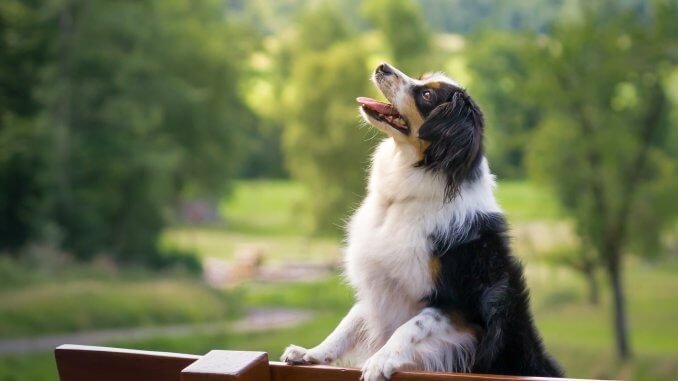
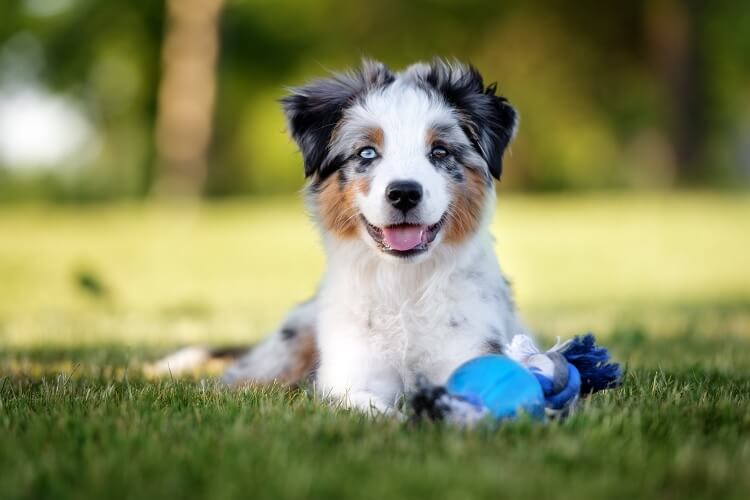
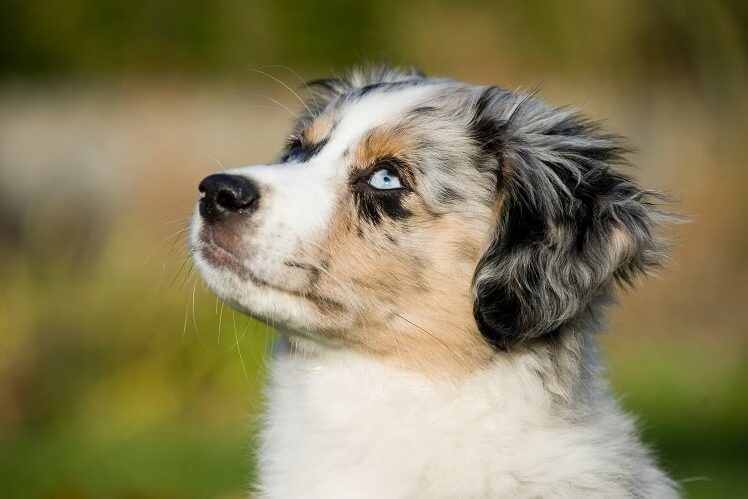
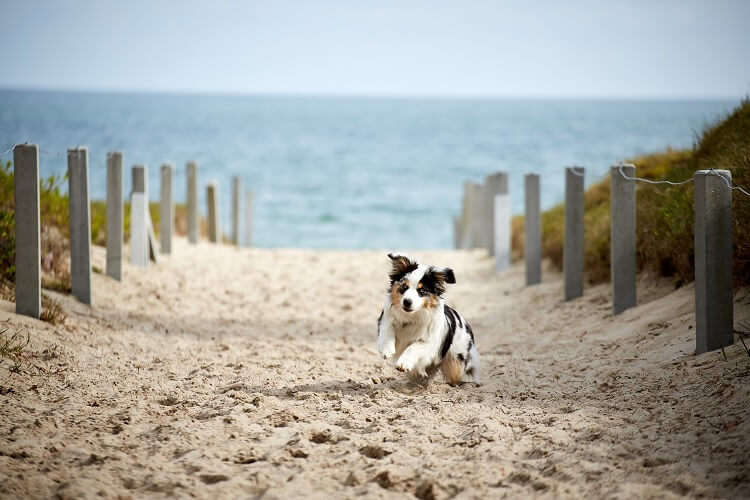
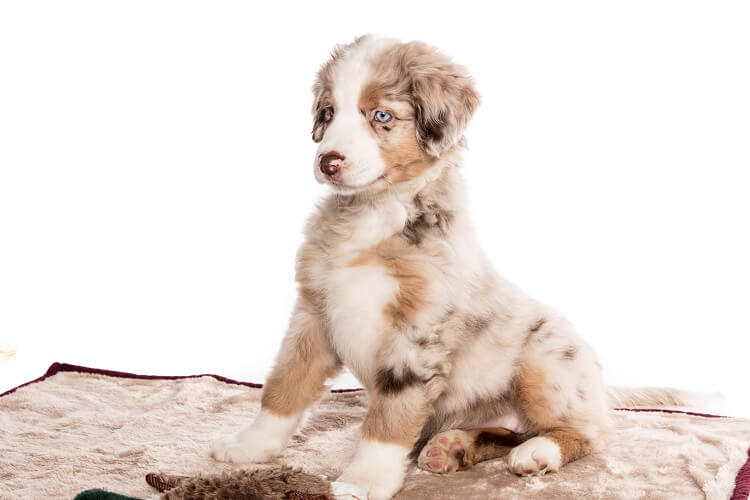
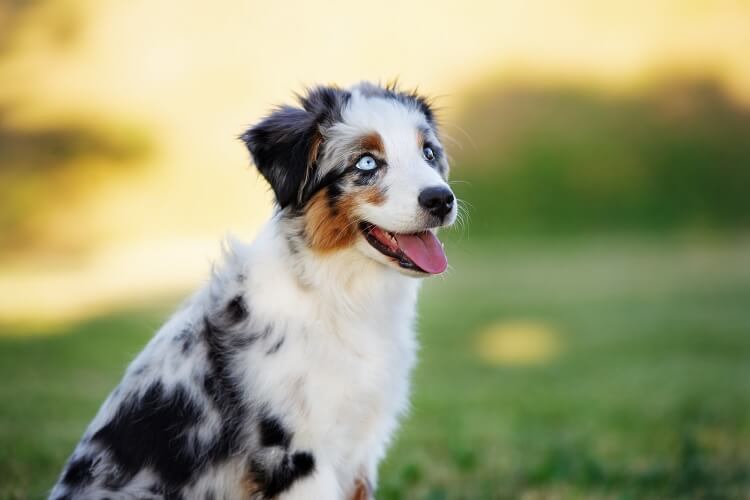
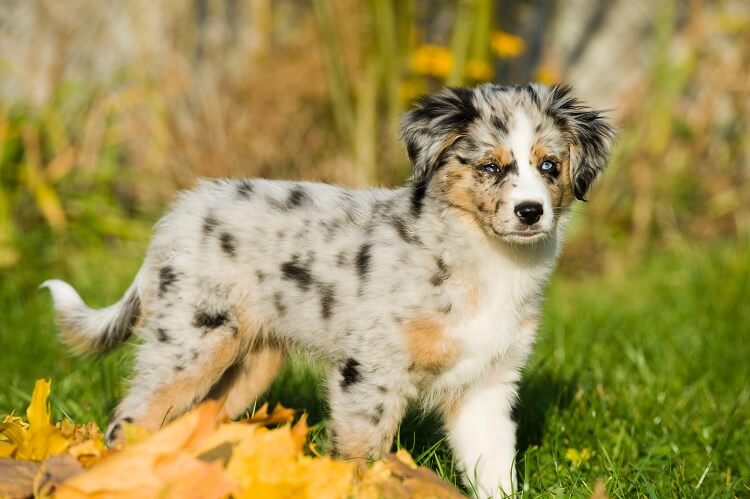
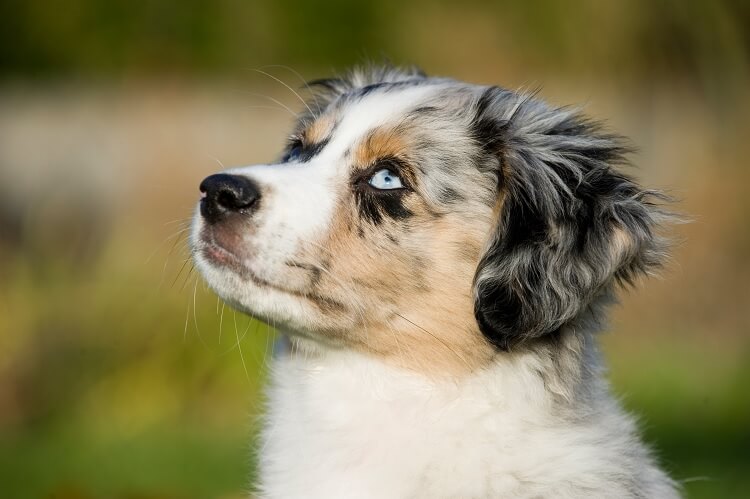

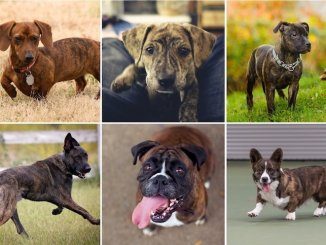
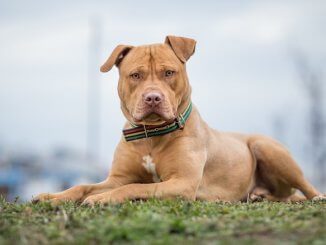
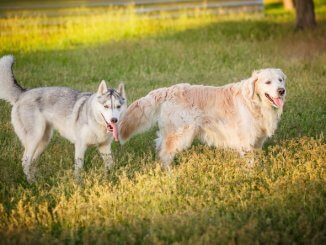
My Mini Aussie, Karma Kai Ling just passed away this summer, at the very old age if 17. I miss her dearly but I’m glad to have spent all the best years of my life with her. She was the best dog I’ve ever had, extremely smart, fun, cool and beautiful liver and white with Amber eyes.
We saved our mini aussie from being euthanized at only 1 1/2 years. She is very smart and is so much fun. She is now 8 and this past year has begun to have eye problems. She is loved dearly and has returned that love and more. For anyone thinking about this breed to bring into their family … go for it. You won’t regret it.
Do you think is should go for it? It would only happen in a years time, so I have a lot more time to research about the breed. How much exercise do you give her daily and what about mental stimulation? Thanks!
I just got an 8 week old female, very pretty girl. We drove 2 hours, she slept the way home. When she got home, she started playing with balls and toys. Went pee-pee on the floor, wiped it up and showed her where the paper towel was. When she went again it was on the towel – very smart pup! Can’t wait to start working with her.
I am a dog lover. I live alone in a townhouse. I am interested in a mini aussie. I am 60. I work 2.5 days a week. I am familiar with dogs and the responsibility of them. Helped raise pedigree german shepherds and have had many dogs in my life. Now that you know all that do you think a mini aussie is a good dog for one person in a townhouse?
Hi Karen,
Making the decision to bring home a new addition is a big one, but you seem to be taking your time to think things through. MAS are an active breed; they love their exercise and thrive when their minds are kept occupied. I would be considering what they will be doing whilst you are at work on the 2.5 days per week. Do you have a friend/family member who can pop in to see them, walk them and play for a short time? The rest of the time, what are your interests or hobbies? Are you quite active? Do you enjoying walking? This would be a bonus with a MAS! They are pretty intelligent; they often pick their training up quite quickly so house-training shouldn’t be too challenging. Are you aware of local puppy classes or play sessions where you could take them to socialize? MAS are great companions so we’re sure you’d find a true friend if you’ve considered how to meet their needs. Good luck!
Hey! If I were to get one, I have a year to do my research so I’m not rushing into it, I know it’s a Big decision!, Would I have to bring the mas to puppy classes? I’m a very shy person and would hate to train/fail in a class full of people and and amazing cute pup’s. I would train the mas in different environments such as my house, the garden and dog parks but I’m not keen on puppy classes. Thanks!
Hi Izzy, puppy classes aren’t essential for every dog. You would have to train in different environments (like you identified) and make sure your pup is being well socialized with other dogs too. If you do this, then you won’t need puppy classes.
I am about to get this breed for my daughter who is 13 for the first time and I am very excited about it..
Izzy,
You will not regret it. Research the breed and what breeders are in your area so you can learn more about them, I’m sure the more you’ll read, the more fascinated you’ll become. As for exercise, they definitely need a lot of it. As long as my mini aussie, Kodak, gets about an hour of running around a day, he’ll usually be good but anything short of an hour, doesn’t work well with him – & trust me – he can go over an hour too. This isn’t anything to be scared of though, just simply letting them out in the backyard to run around and catch a ball is enough. For mental stimulation, this breed literally BREATHES to PLEASE you. We are constantly learning & working on new tricks & he’s so eager to get them down. They want to learn & have challenges; do activities, make obstacles, get them puzzle toys. There is so much to offer for them & eventually, once they’ve learned enough from you, YOU will start to learn from THEM. I love my mini aussie, he’s the sweetest, more caring, loyal, & intelligent dog I’ve ever come across in my life!
I’m interest a male poppy mini Aussie.
I’m watching my brother assume for three months, he is 2 years old. I have two dogs and three cats. Everything I was reading states they are not good around small animals. Is this true? The assie has never been around other dogs, any suggestions on how to make this a easy transition?
their beautiful dogs i plan to purchase poppy in future